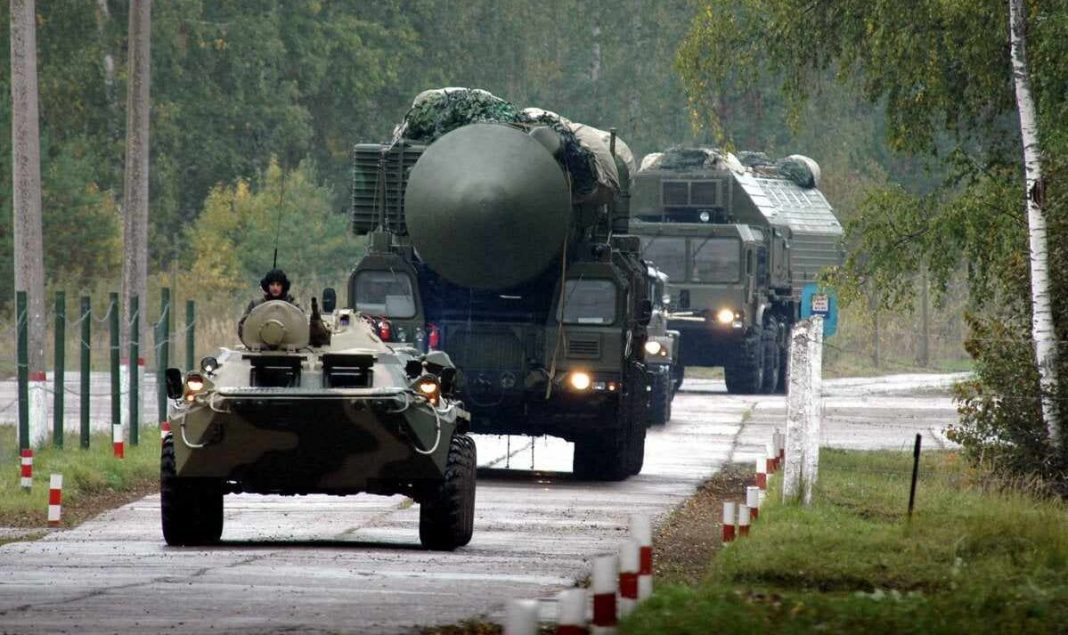On March 22, 2023, on the occasion of the 80th anniversary of the Khatyn tragedy, Alexander Lukashenko visited the renovated Khatyn memorial complex, where he paid tribute to the victims. There he held a meeting with journalists, answering some questions.
“Recently, the British authorities announced their intention to supply Ukraine with depleted uranium ammunition”, – one of the Russian journalists began his question – “Please tell me…”
“I’ll tell you!” – without waiting for the end of the question, Lukashenko began, – “and Russia will supply us with ammunition with real uranium. If they [the UK] are crazy, they will boost this.”
Such a response from the Belarusian president caused a wide reaction. In the public space, for the first time, they started talking about a new type of nuclear blackmail from Moscow, according to which nuclear weapons could soon be deployed on the territory of Belarus.
Already on March 25, a few days after the end of Xi Jinping’s visit to Moscow, the Russia 1 TV Channel aired an interview with Vladimir Putin. In it, he, among other things, touched upon the topic of Belarus:
“As for our negotiations with Lukashenko, even outside the context of these events, Alexander Lukashenko has long questioned deploying Russian tactical nuclear weapons on the territory of Belarus. First, the US has been doing this for decades. They placed it in six states of Europe. And [with Lukashenko], we agreed that we would do the same. On July 1, we are completing the construction of a special storage facility for tactical nuclear weapons on the territory of Belarus.”
Exactly two months later, on May 25, at a meeting in Minsk, the defence ministers of Belarus and Russia signed documents defining the procedure for keeping Russian “non-strategic nuclear weapons” in a particular storage facility on the territory of Belarus. On the same day, Alexander Lukashenko said that the transfer of Russian nuclear weapons to the territory of Belarus had already begun.
In this article, Ascolta analyses Belarus’ attempt to return to the “nuclear club” and create a new threat to Europe and strategic stability on the world stage. Based on data from our sources, we determine possible locations for deploying nuclear weapons on the territory of Belarus and routes for their delivery.
This Content Is Only For Subscribers
At the time of the collapse of the Soviet Union, Belarus was the eighth country in the world in terms of stockpiles of nuclear weapons, with a total number of warheads of 1120 pieces. The grouping of strategic nuclear forces included about 180 formations, units and institutions numbering about 40 thousand people. At the same time, in the early 90s, Belarus became one of the first states in the world to voluntarily renounce nuclear weapons (together with South Africa, Ukraine and Kazakhstan).
3 days after the start of Russia’s full-scale invasion of the territory of Ukraine, on February 27, 2022, a Republican referendum was held in Belarus on the issue of amending and supplementing the Constitution. Under the slogan “To the Future Together”, the new version of the Constitution was supported by 82.6% of the voters. In addition to some fundamental changes, the new Constitution of Belarus also lost Article 18, which prescribed the non-nuclear course of the country.
“Legalisation” of the nuclear weapons transfer to the Belarus territory
As early as May 25, 2023, the defence ministers of Belarus and Russia not only signed documents defining the procedure for keeping Russian “non-strategic nuclear weapons” in a special storage facility on the territory of Belarus. They also officially fixed the time frame for delivering and deploying tactical nuclear weapons in their locations in Belarus.
A few weeks later, on June 9, another meeting of the leaders of Russia and Belarus took place at Putin’s residence in Sochi. During a dinner on the summer terrace of the residence, Vladimir Putin said that the transfer of nuclear weapons would begin immediately after the preparation of facilities for them was completed on July 7-8. At the same time, on June 13, at a briefing at the White House, the coordinator of the US National Security Council, John Kirby, said that the United States does not see any signs of either preparation for the deployment of nuclear weapons or the process of moving nuclear weapons from Russia to Belarus.
Ascolta suggests that such a position of the United States may indicate that the preparations for deploying nuclear weapons in special storage facilities on the territory of Belarus began several years earlier. According to information from our sources in Minsk, agreements on the deployment of tactical nuclear weapons by Russia in Belarus were reached in 2020. It is likely that against the background of mass protests in large cities of Belarus and the non-recognition of the legitimacy of the electoral process by some Western states, Alexander Lukashenko was forced to accept Putin’s conditions in exchange for maintaining his own positions. In this case, it is essential to note that if such agreements occurred, then Beijing was aware of them.
At the same time, many military experts believe this topic was first raised in June 2021 during a visit to Belarus by the Secretary of the Security Council of the Russian Federation, Nikolai Patrushev. Since then, the media has actively raised the possibility of deploying nuclear weapons on the territory of Belarus.
Locations of nuclear weapons carriers on the territory of Belarus
In April 2023, Alexander Lukashenko once again stated that Belarus possesses all the necessary technical means for storing and using nuclear weapons. In particular, information about the modernisation of Su-25 aircraft, on which systems for the use of nuclear warheads were installed, was often broadcast; Belarusian missile crews and air crews underwent an entire cycle of training in the operation and use of tactical nuclear charges. There was also mention of the transfer by Russia of the new Iskander-M complex, which is also capable of using missiles with nuclear warheads. By the middle of the year, the deal was expected to be closed to transfer new Su-30MS aircraft, which are also capable of carrying nuclear warheads, to the Belarusian Air Force.
Based on these data, it is possible to determine the main locations of nuclear weapons carriers on the territory of Belarus:
- 465th missile brigade (military unit 61732, Tsel, Mogilev region) – OTRK “Iskander-M”;
- 25th arsenal of rocket and artillery weapons (military unit 25819, Navakolasava village (Minsk region) – OTRK “Iskander-M”;
- 116th Guards Assault Aviation Base (military unit 19764, Lida, Grodno region) – Su-25 attack aircraft;
- 61st Fighter Air Base (military unit 54804, Baranovichi, Brest region) – Su-30SM fighters;
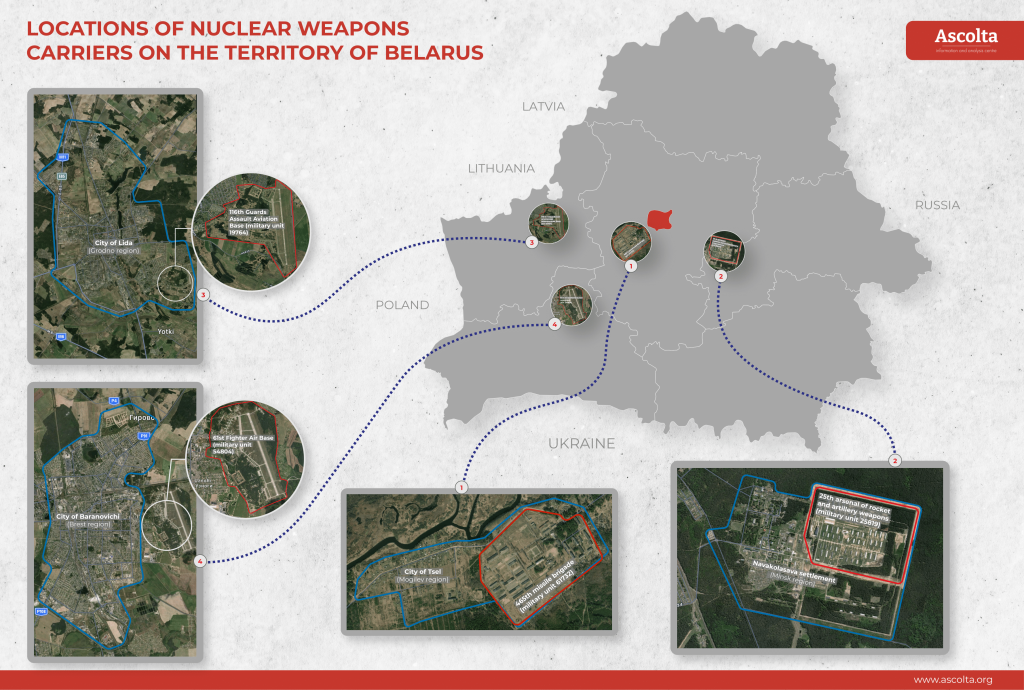
The information on planned usage of five test sites in Belarus to deploy nuclear weapons was actually confirmed by the Minister of Defense of the Russian Federation, Sergei Shoigu on April 10, 2023, in Minsk:
– “I have, of course, the relevant powers and instructions of our President, Supreme Commander-in-Chief. I would like to express separate words of gratitude to your Ministry of Defense and you personally. Five polygons were established on the territory of Belarus. They are prepared and equipped. Moreover, a sufficient number of instructors are involved – officers of the Belarusian Armed Forces to train, including our replenishment. Indeed, there is quite a large group. And we, of course, will consider all the issues of her further stay and preparation and, probably, expanding the scope you discussed with Vladimir Vladimirovich.”
On December 19, 2022, Alexander Lukashenko announced that the Russian S-400 and Iskander-M complexes were put on combat duty in Belarus. He also noted that the Iskander-M complexes can use nuclear warheads.
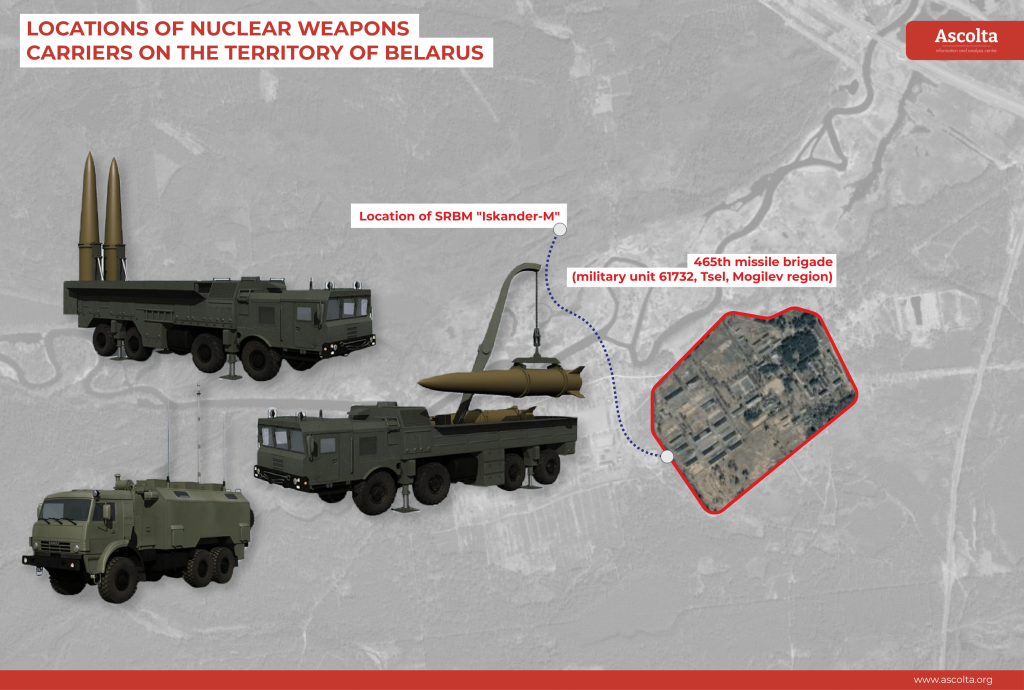
Already on April 3, 2023, at a conference call with the leadership of the Armed Forces, Russian Defense Minister Sergei Shoigu announced that Russia had handed over to Belarus another Iskander-M missile system and also focused on the possibility of using nuclear warheads: tactical missile system “Iskander-M”. It can use both conventional and nuclear missiles.”
On April 7, the calculation of the Iskander-M OTRK of the 465th missile brigade of the Armed Forces of the Republic of Belarus (Tsel, Mogilev region) departed for Russia for practical training.
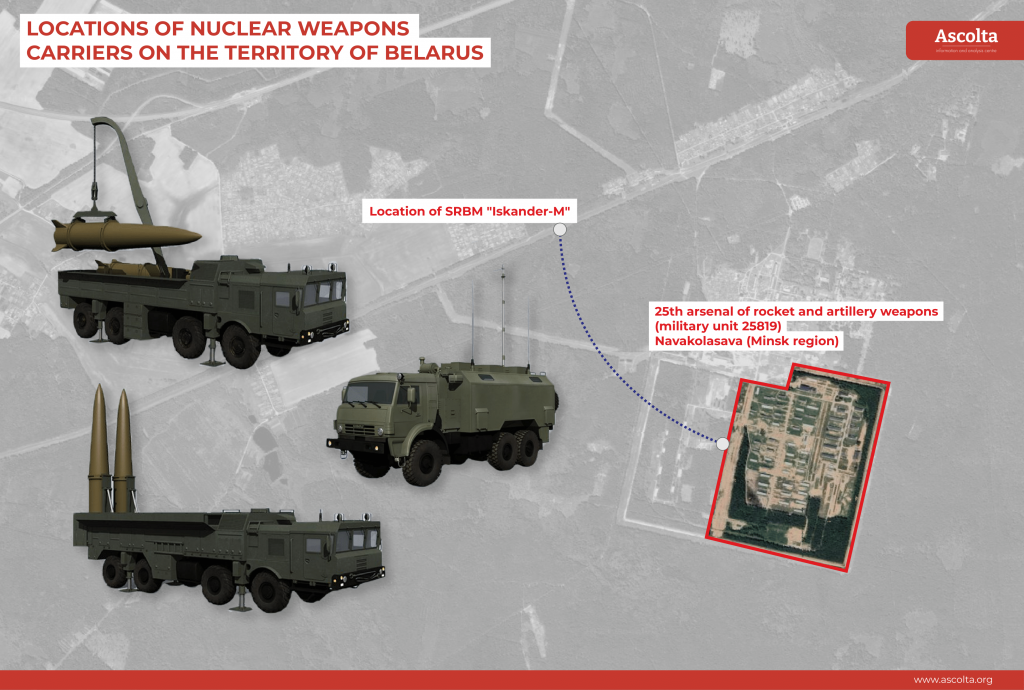
The exact number of missile systems of this type in service in Belarus remains unspecified. At the same time, according to the data obtained, two places of deployment of Iskander-M can be determined.
On June 26, 2022, during a meeting in St. Petersburg, the Russian and Belarusian leaders discussed supplying Russian weapons to the Belarusian army. Then Vladimir Putin noted that those Su-25s in service with the Belarusian army needed to be modernised at aircraft factories in Russia so that they could carry nuclear charges. The conditions for the retraining of Belarusian pilots were also agreed upon.
On October 15, 2022, Alexander Lukashenko announced the establishment of a regional grouping of troops of Russia and Belarus since provocations are being prepared from Poland, and nuclear weapons may appear near Poland on the border with Belarus. On the same day, the Russian Foreign Ministry confirmed the re-equipment of Belarusian Su-25 aircraft with the technical capabilities to carry nuclear weapons.
At the same time, Lukashenko announced the completion of the Su-25 re-equipment in July. True, then he did not name specific models but only said we were talking about “Su”. According to open data, the Belarusian Air Force is armed with 38 Su-25s, 20 Su-27s, and 6 Su-37s (6 more should be delivered by Russia soon).
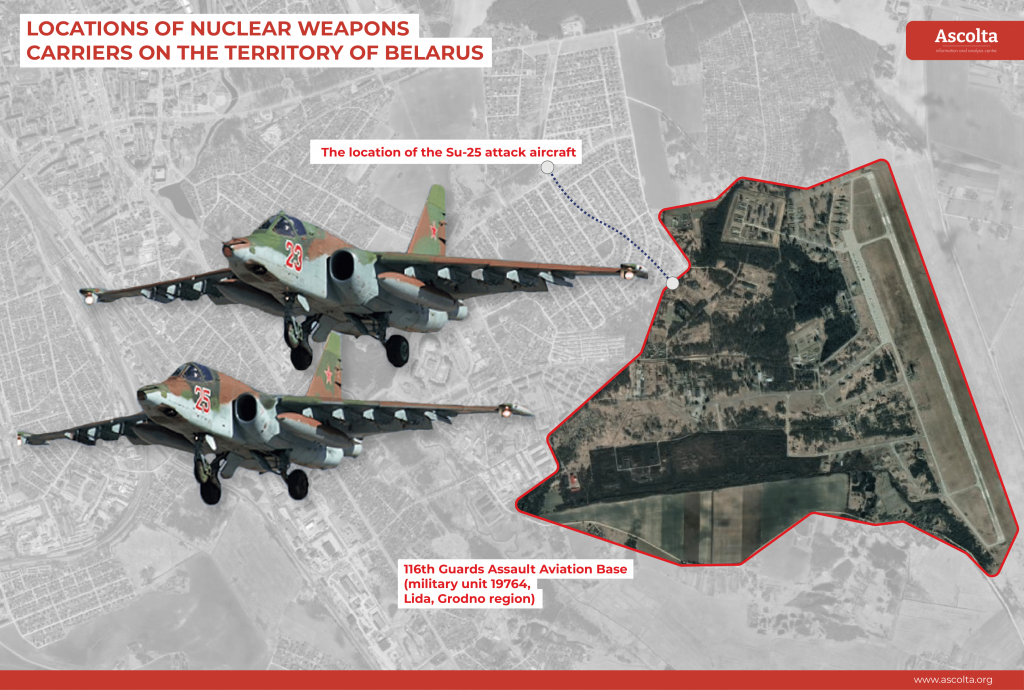
Notably, the contract for supplying 12 Su-30SM fighters, which can carry nuclear warheads, was signed between Belarus and Russia in 2019. In November of the same year, the first four aircraft were delivered. Already in October 2022, four more Su-30SMs arrived in Belarus.
On February 5, 2023, on the day of the Belarusian Air Force, Andrey Lukyanovich, Commander of the Air Force and Air Defense Forces of the Belarusian Armed Forces, said that Belarus would receive a third batch of Su-30SM fighters shortly. On May 15, he again announced receiving four Su-30SMs, but apparently, this process was delayed. As of the end of July 2023, this batch of aircraft has yet to be delivered to Belarus.
At the same time, it is worth noting that, according to official data, the Belarusian Air Force is armed with 8 Su-30SM fighters, which can also carry nuclear warheads.
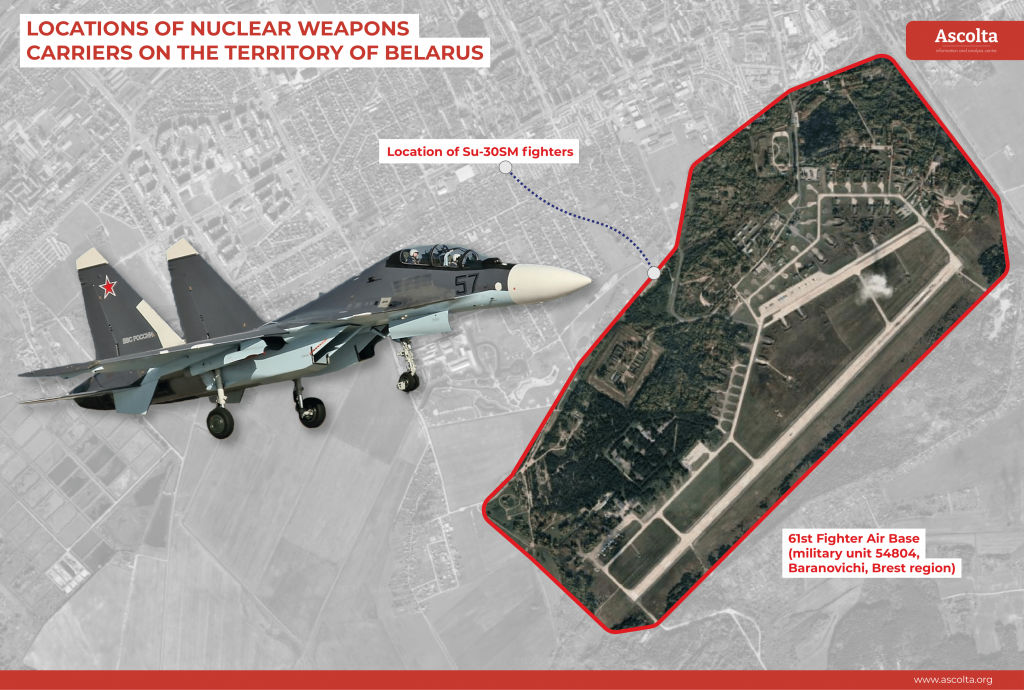
Nuclear weapons storage sites
In Soviet times, four missile divisions were located in Belarus: Pruzhany, Postavy, Mozyr and Lida. They were armed with R-12, R-14 and RSD-10 mobile and silo-based missiles. Some forces of these divisions were also deployed in the Smorgon, Dzerzhinsky, Dyatlovsky and Slonim regions.
In addition, there were two mine launch complexes on the territory of Belarus. The first secret object was based in the Postavy region and was equipped with R-12U missiles – the Dvina mine launcher. The second was located near Smorgon and was loaded with R-14U missiles – the Chusovaya Mine Launcher. However, nuclear warheads were located not only in silo launchers (silo launchers); in total, from 1960-1996, there were at least 33 locations in Belarus where nuclear weapons were located.
As of 1996, Topol mobile strategic missile systems were deployed on the territory of missile regiments:
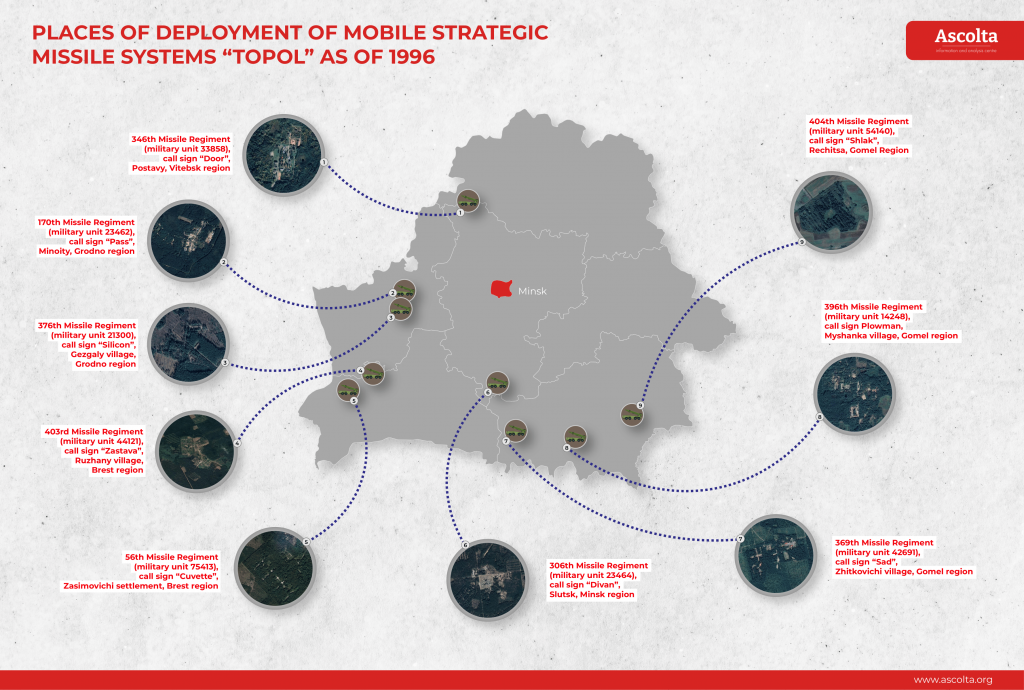
Taking into account the information received from our own sources, as well as comparing the data with the locations of nuclear weapons carriers, Ascolta assumes that the following test sites will be used to store nuclear warheads on the territory of Belarus: Zasimovichi (Brest region), Zhitkovichi (Gomel region), Postavy (Vitebsk region), Minoyty (Grodno region), Gezgaly (Grodno region). Modernisation of them has already been completed or will be completed soon.
At the same time, the issue of creating (or restoring old) nuclear weapons storage sites in the Vitebsk region remains open. In August 2022, several Ascolta sources reported that Iskander missiles without nuclear warheads arrived in the north of Belarus. Later, similar information began to appear in some telegram channels. At the same time, there is still no evidence that such deliveries were actually carried out.
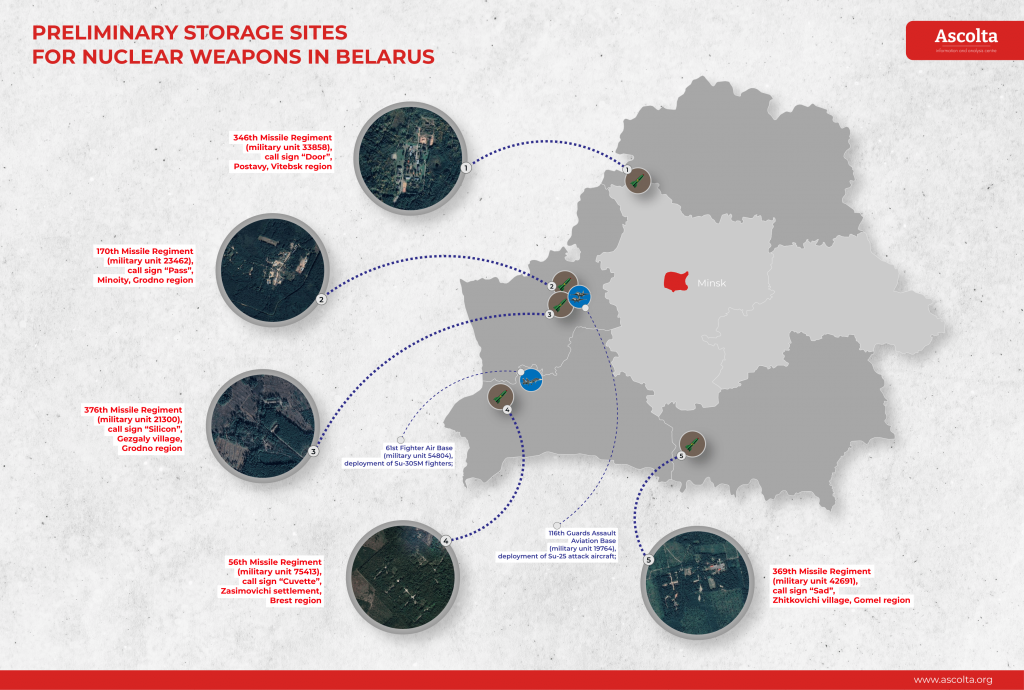
It is important to note that on April 17, 2023, the Minister of Defense of the Republic of Belarus, Viktor Khrenin, stated: “If necessary, strategic nuclear weapons can also be deployed in Belarus. For this, the military is already preparing the existing sites.”
During the interview with the Russian President, published on March 25, 2023 (mentioned above), Vladimir Putin also stated that a new storage facility for nuclear warheads is being built on the territory of Belarus. All works should be completed by July 1. At the same time, according to Ascolta, this statement is not valid. In fact, the old Gomel-30 storage facility is being modernised in the Gomel region, near the village of Zarechye, on the territory where the 33rd missile division of the 43rd missile army (military unit 42654) was stationed in Soviet times.
According to data requiring additional confirmation, several nuclear warheads were delivered to this test site at the very beginning of 2023.
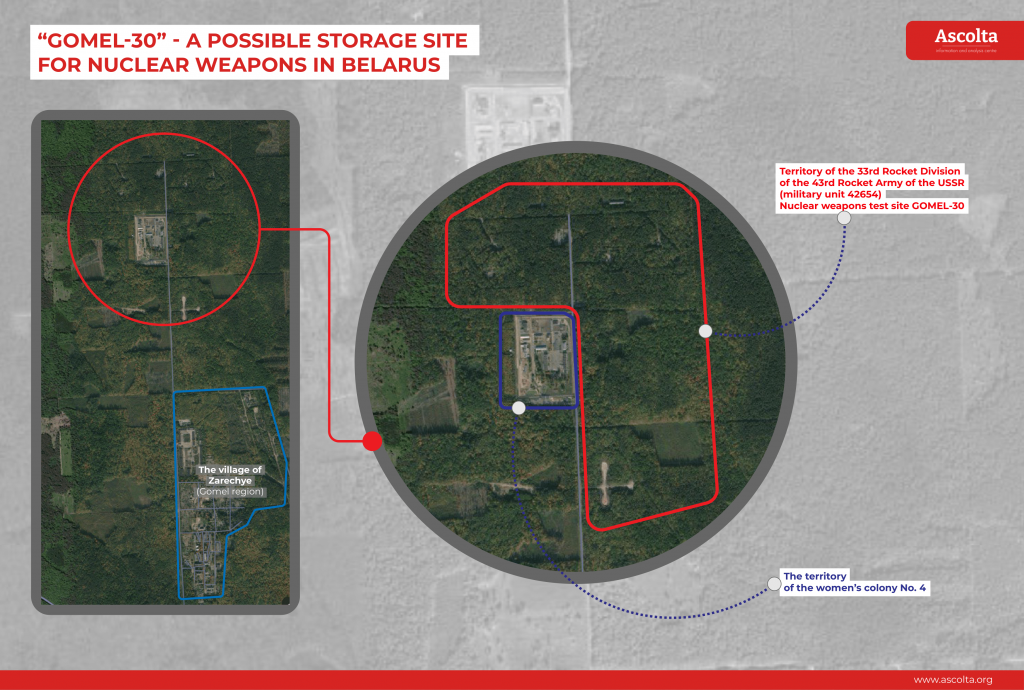
Colonel Roman Chekhov, Chief of Missile Troops and Artillery of the General Staff of the Armed Forces of the Republic of Belarus, has been appointed responsible for carrying out the necessary work and preparing to deploy new weapons. Chekhov was appointed to this post in August 2022.
Delivery of nuclear weapons to the territory of Belarus
It is important to pay attention to the regular appeal of Russian officials to the practice of NATO nuclear missions. At the same time, Russian intelligence agencies publicly announce the deployment of 150-200 US nuclear bombs (B61-3/-4/-7) in Europe and Turkey. Based on such rhetoric, it can be assumed that the minimum number of Russian nuclear weapons on the territory of Belarus will be about 200 units.
On June 27, 2023, Alexander Lukashenko confirmed that Russian nuclear weapons had already arrived in Belarus. Notably, such a statement was made against the backdrop of the completion of the “military rebellion” by PMC Wagner and Yevgeny Prigozhin, which began on the evening of June 23, 2023. It can be assumed that, in this case, the “mutiny” itself could also be used to divert attention from the transport of nuclear weapons to the territory of Belarus. Earlier, Ascolta repeatedly wrote that the “mutiny” looked too feigned, and all processes were controlled by the Kremlin.
That is an interesting point. According to several statements in the media and published satellite images, a base was created in the city of Tsel, Minsk region, to deploy Wagner PMC fighters, who are actively moving to the territory of Belarus. Moreover, the coordinates of the new Wagner PMC base coincide entirely with the coordinates of the deployment of the 465th missile brigade (military unit 61732) and the proposed deployment of the Iskander-M OTRK.
Based on the statements of Alexander Lukashenko and Vladimir Putin, it can be concluded that the first batch of nuclear weapons was delivered to Belarus by mid-June and was probably transferred by air. According to monitoring groups, since March 25, 2023, when Vladimir Putin first announced the creation of a storage facility for the Russian heavy nuclear arsenal, about 70 flights of transport aircraft of the Russian Aerospace Forces (An-124, Il-76, An -12, An-72, An-26). However, during this period, rocket attacks from the territory of Belarus on the territory of Ukraine were not recorded, and there was also no increase in the number of Russian troops.
Without reliable data, one can only assume that at least half of these flights could carry several nuclear weapons. Thus, the total number of nuclear weapons transported by air could reach from 70 to 140 units. It should be noted that the main delivery sites (Baranovichi Airfield, Machulishchi Airfield, Lida Airfield and Gomel Airport) coincide with possible storage sites for the Russian heavy nuclear arsenal.
It should be noted that tactical nuclear munitions, the deployment of which the official authorities of Russia and Belarus declare, have more compact weight and size characteristics and can be transported by various modes of transport. At the same time, using rail transport to move nuclear weapons can provide the highest level of security and confidentiality. Moreover, multiple types of wagons can be used for tactical nuclear warheads, including specially equipped containers that do not look different from ordinary ones. With a high degree of confidence, it can be argued that tactical nuclear weapons will be delivered to Belarus this way. However, this does not exclude the possibility of using other modes of transport, such as aviation, to deliver specific batches of nuclear weapons.
Moreover, at the end of June 2023, information was published, allegedly extracted by the Community of Railway Workers of Belarus from railway transportation databases, according to which the following points are the initial departure stations of Russian nuclear weapons: Sarov Station (Gorkovskaya Railway), Mir Station (Sverdlovsk Railway), Krasnaya Gorka Station (South Ural Railway), Seliksa Station (Kuibyshevskaya Railway). It is noteworthy that enterprises of the nuclear weapons complex of the Russian Federation are located near each of the above stations.
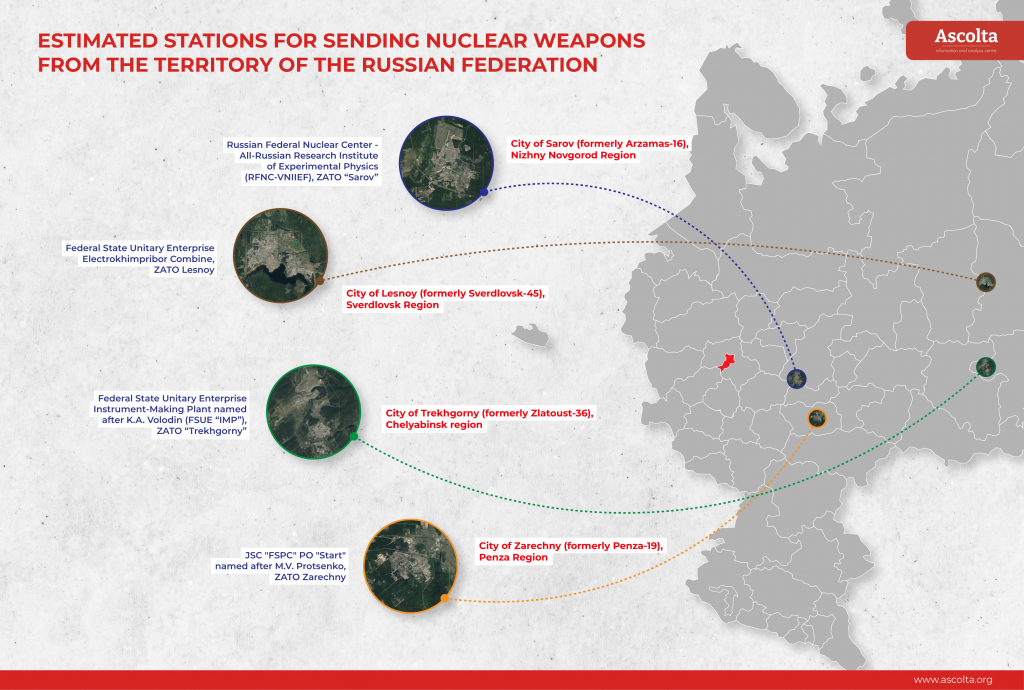
It seems that nuclear weapons will not be sent directly to Belarus from the central nuclear weapons storage bases of the 12th Main Directorate of the Russian Ministry of Defense. Instead, they will be transported from Russian nuclear power plants. First, they will be delivered to intermediate dispatch stations in Russia, and then they will go to Belarus. The deliveries of the Russian heavy nuclear arsenal and the equipment necessary for its operation to Belarus will be carried out in three stages from June to November 2023.
According to the Belarusian Railway Association, Russian heavy nuclear weapons and related equipment will be delivered to Belarus in three stages from June to November 2023. In the first and second stages, nuclear weapons will be delivered to the Prudok railway station, which is located in the Vitebsk branch of the Belarusian Railway. Then, further distribution of heavy nuclear weapons to storage sites in special military units will be carried out, depending on their type. In the third stage, the cars will be sent to the Baranovichi-Polessky station, passing through the Baranovichi-Tsentralny station, for subsequent relocation to the territory of the 61st Fighter Air Base of the Air Force of the Republic of Belarus (military unit 54804).
Presumably, from June to November 2023, 36 covered wagons of unique rolling stock will be delivered to Belarus. Each of these special V60/V-60M wagons can carry between 10 and 20 tactical nuclear warheads. Therefore, the total number of tactical nuclear warheads delivered could be between 360 and 720.
Notably, such several warheads fully comply with the Soviet standard for conducting an offensive front operation, where 600-700 tactical nuclear weapons are required.

